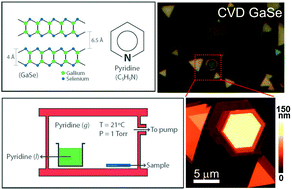Engineering excitonic dynamics and environmental stability of post-transition metal chalcogenides by pyridine functionalization technique†
Abstract
Owing to their strong photon emission, low excitonic binding energies, and nearly-ideal band offset values for water splitting reactions, direct gap quasi-2D gallium chalcogenides are potential candidates for applications in energy harvesting, optoelectronics, and photonics. Unlike other 2D materials systems, chemical functionalization of gallium chalcogenides is still at its seminal stages. Here, we propose vapor phase pyridine intercalation technique to manipulate optical properties of gallium chalcogenides. After functionalization, the excitonic dynamics of quasi-2D GaSe change significantly as evidenced by an increase in integrated PL intensity and emergence of a new emission feature that is below the band edge. Based on our DFT calculations, we attribute these to formation of bound exciton complexes at the trap sites introduced by chemical reaction between pyridine and GaSe. On the contrary, pyridine functionalization does not impact the optical properties of GaTe, instead treats GaTe surface to prevent oxidization of tellurium atoms. Overall, results suggest novel ways to control properties of gallium chalcogenides on demand and unleash their full potential for a range of applications in photonics and optoelectronics.


 Please wait while we load your content...
Please wait while we load your content...